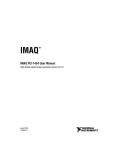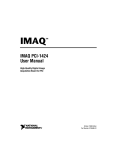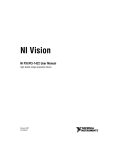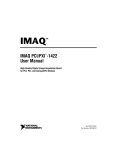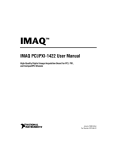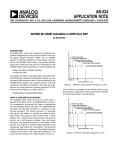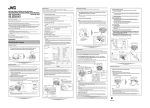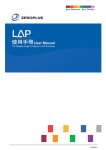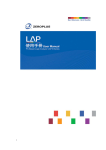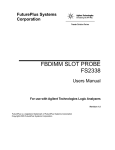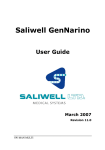Download NI PCI-1424 User Manual
Transcript
NI Vision NI PCI-1424 User Manual High-Quality Digital Image Acquisition Device NI PCI-1424 User Manual February 2007 371869D-01 Support Worldwide Technical Support and Product Information ni.com National Instruments Corporate Headquarters 11500 North Mopac Expressway Austin, Texas 78759-3504 USA Tel: 512 683 0100 Worldwide Offices Australia 1800 300 800, Austria 43 0 662 45 79 90 0, Belgium 32 0 2 757 00 20, Brazil 55 11 3262 3599, Canada 800 433 3488, China 86 21 6555 7838, Czech Republic 420 224 235 774, Denmark 45 45 76 26 00, Finland 385 0 9 725 725 11, France 33 0 1 48 14 24 24, Germany 49 0 89 741 31 30, India 91 80 41190000, Israel 972 0 3 6393737, Italy 39 02 413091, Japan 81 3 5472 2970, Korea 82 02 3451 3400, Lebanon 961 0 1 33 28 28, Malaysia 1800 887710, Mexico 01 800 010 0793, Netherlands 31 0 348 433 466, New Zealand 0800 553 322, Norway 47 0 66 90 76 60, Poland 48 22 3390150, Portugal 351 210 311 210, Russia 7 495 783 68 51, Singapore 1800 226 5886, Slovenia 386 3 425 42 00, South Africa 27 0 11 805 8197, Spain 34 91 640 0085, Sweden 46 0 8 587 895 00, Switzerland 41 56 200 51 51, Taiwan 886 02 2377 2222, Thailand 662 278 6777, Turkey 90 212 279 3031, United Kingdom 44 0 1635 523545 For further support information, refer to the Technical Support and Professional Services appendix. To comment on National Instruments documentation, refer to the National Instruments Web site at ni.com/info and enter the info code feedback. © 1999–2007 National Instruments Corporation. All rights reserved. Important Information Warranty The NI PCI-1424 is warranted against defects in materials and workmanship for a period of one year from the date of shipment, as evidenced by receipts or other documentation. National Instruments will, at its option, repair or replace equipment that proves to be defective during the warranty period. This warranty includes parts and labor. The media on which you receive National Instruments software are warranted not to fail to execute programming instructions, due to defects in materials and workmanship, for a period of 90 days from date of shipment, as evidenced by receipts or other documentation. National Instruments will, at its option, repair or replace software media that do not execute programming instructions if National Instruments receives notice of such defects during the warranty period. National Instruments does not warrant that the operation of the software shall be uninterrupted or error free. A Return Material Authorization (RMA) number must be obtained from the factory and clearly marked on the outside of the package before any equipment will be accepted for warranty work. National Instruments will pay the shipping costs of returning to the owner parts which are covered by warranty. National Instruments believes that the information in this document is accurate. The document has been carefully reviewed for technical accuracy. In the event that technical or typographical errors exist, National Instruments reserves the right to make changes to subsequent editions of this document without prior notice to holders of this edition. The reader should consult National Instruments if errors are suspected. In no event shall National Instruments be liable for any damages arising out of or related to this document or the information contained in it. EXCEPT AS SPECIFIED HEREIN, NATIONAL INSTRUMENTS MAKES NO WARRANTIES, EXPRESS OR IMPLIED, AND SPECIFICALLY DISCLAIMS ANY WARRANTY OF MERCHANTABILITY OR FITNESS FOR A PARTICULAR PURPOSE. CUSTOMER’S RIGHT TO RECOVER DAMAGES CAUSED BY FAULT OR NEGLIGENCE ON THE PART OF NATIONAL INSTRUMENTS SHALL BE LIMITED TO THE AMOUNT THERETOFORE PAID BY THE CUSTOMER. NATIONAL INSTRUMENTS WILL NOT BE LIABLE FOR DAMAGES RESULTING FROM LOSS OF DATA, PROFITS, USE OF PRODUCTS, OR INCIDENTAL OR CONSEQUENTIAL DAMAGES, EVEN IF ADVISED OF THE POSSIBILITY THEREOF. This limitation of the liability of National Instruments will apply regardless of the form of action, whether in contract or tort, including negligence. Any action against National Instruments must be brought within one year after the cause of action accrues. National Instruments shall not be liable for any delay in performance due to causes beyond its reasonable control. The warranty provided herein does not cover damages, defects, malfunctions, or service failures caused by owner’s failure to follow the National Instruments installation, operation, or maintenance instructions; owner’s modification of the product; owner’s abuse, misuse, or negligent acts; and power failure or surges, fire, flood, accident, actions of third parties, or other events outside reasonable control. Copyright Under the copyright laws, this publication may not be reproduced or transmitted in any form, electronic or mechanical, including photocopying, recording, storing in an information retrieval system, or translating, in whole or in part, without the prior written consent of National Instruments Corporation. National Instruments respects the intellectual property of others, and we ask our users to do the same. NI software is protected by copyright and other intellectual property laws. Where NI software may be used to reproduce software or other materials belonging to others, you may use NI software only to reproduce materials that you may reproduce in accordance with the terms of any applicable license or other legal restriction. Trademarks National Instruments, NI, ni.com, and LabVIEW are trademarks of National Instruments Corporation. Refer to the Terms of Use section on ni.com/legal for more information about National Instruments trademarks. Other product and company names mentioned herein are trademarks or trade names of their respective companies. Members of the National Instruments Alliance Partner Program are business entities independent from National Instruments and have no agency, partnership, or joint-venture relationship with National Instruments. Patents For patents covering National Instruments products, refer to the appropriate location: Help»Patents in your software, the patents.txt file on your CD, or ni.com/patents. WARNING REGARDING USE OF NATIONAL INSTRUMENTS PRODUCTS (1) NATIONAL INSTRUMENTS PRODUCTS ARE NOT DESIGNED WITH COMPONENTS AND TESTING FOR A LEVEL OF RELIABILITY SUITABLE FOR USE IN OR IN CONNECTION WITH SURGICAL IMPLANTS OR AS CRITICAL COMPONENTS IN ANY LIFE SUPPORT SYSTEMS WHOSE FAILURE TO PERFORM CAN REASONABLY BE EXPECTED TO CAUSE SIGNIFICANT INJURY TO A HUMAN. (2) IN ANY APPLICATION, INCLUDING THE ABOVE, RELIABILITY OF OPERATION OF THE SOFTWARE PRODUCTS CAN BE IMPAIRED BY ADVERSE FACTORS, INCLUDING BUT NOT LIMITED TO FLUCTUATIONS IN ELECTRICAL POWER SUPPLY, COMPUTER HARDWARE MALFUNCTIONS, COMPUTER OPERATING SYSTEM SOFTWARE FITNESS, FITNESS OF COMPILERS AND DEVELOPMENT SOFTWARE USED TO DEVELOP AN APPLICATION, INSTALLATION ERRORS, SOFTWARE AND HARDWARE COMPATIBILITY PROBLEMS, MALFUNCTIONS OR FAILURES OF ELECTRONIC MONITORING OR CONTROL DEVICES, TRANSIENT FAILURES OF ELECTRONIC SYSTEMS (HARDWARE AND/OR SOFTWARE), UNANTICIPATED USES OR MISUSES, OR ERRORS ON THE PART OF THE USER OR APPLICATIONS DESIGNER (ADVERSE FACTORS SUCH AS THESE ARE HEREAFTER COLLECTIVELY TERMED “SYSTEM FAILURES”). ANY APPLICATION WHERE A SYSTEM FAILURE WOULD CREATE A RISK OF HARM TO PROPERTY OR PERSONS (INCLUDING THE RISK OF BODILY INJURY AND DEATH) SHOULD NOT BE RELIANT SOLELY UPON ONE FORM OF ELECTRONIC SYSTEM DUE TO THE RISK OF SYSTEM FAILURE. TO AVOID DAMAGE, INJURY, OR DEATH, THE USER OR APPLICATION DESIGNER MUST TAKE REASONABLY PRUDENT STEPS TO PROTECT AGAINST SYSTEM FAILURES, INCLUDING BUT NOT LIMITED TO BACK-UP OR SHUT DOWN MECHANISMS. BECAUSE EACH END-USER SYSTEM IS CUSTOMIZED AND DIFFERS FROM NATIONAL INSTRUMENTS' TESTING PLATFORMS AND BECAUSE A USER OR APPLICATION DESIGNER MAY USE NATIONAL INSTRUMENTS PRODUCTS IN COMBINATION WITH OTHER PRODUCTS IN A MANNER NOT EVALUATED OR CONTEMPLATED BY NATIONAL INSTRUMENTS, THE USER OR APPLICATION DESIGNER IS ULTIMATELY RESPONSIBLE FOR VERIFYING AND VALIDATING THE SUITABILITY OF NATIONAL INSTRUMENTS PRODUCTS WHENEVER NATIONAL INSTRUMENTS PRODUCTS ARE INCORPORATED IN A SYSTEM OR APPLICATION, INCLUDING, WITHOUT LIMITATION, THE APPROPRIATE DESIGN, PROCESS AND SAFETY LEVEL OF SUCH SYSTEM OR APPLICATION. Compliance Compliance with FCC/Canada Radio Frequency Interference Regulations Determining FCC Class The Federal Communications Commission (FCC) has rules to protect wireless communications from interference. The FCC places digital electronics into two classes. These classes are known as Class A (for use in industrial-commercial locations only) or Class B (for use in residential or commercial locations). All National Instruments (NI) products are FCC Class A products. Depending on where it is operated, this Class A product could be subject to restrictions in the FCC rules. (In Canada, the Department of Communications (DOC), of Industry Canada, regulates wireless interference in much the same way.) Digital electronics emit weak signals during normal operation that can affect radio, television, or other wireless products. All Class A products display a simple warning statement of one paragraph in length regarding interference and undesired operation. The FCC rules have restrictions regarding the locations where FCC Class A products can be operated. Consult the FCC Web site at www.fcc.gov for more information. FCC/DOC Warnings This equipment generates and uses radio frequency energy and, if not installed and used in strict accordance with the instructions in this manual and the CE marking Declaration of Conformity*, may cause interference to radio and television reception. Classification requirements are the same for the Federal Communications Commission (FCC) and the Canadian Department of Communications (DOC). Changes or modifications not expressly approved by NI could void the user’s authority to operate the equipment under the FCC Rules. Class A Federal Communications Commission This equipment has been tested and found to comply with the limits for a Class A digital device, pursuant to part 15 of the FCC Rules. These limits are designed to provide reasonable protection against harmful interference when the equipment is operated in a commercial environment. This equipment generates, uses, and can radiate radio frequency energy and, if not installed and used in accordance with the instruction manual, may cause harmful interference to radio communications. Operation of this equipment in a residential area is likely to cause harmful interference in which case the user is required to correct the interference at their own expense. Canadian Department of Communications This Class A digital apparatus meets all requirements of the Canadian Interference-Causing Equipment Regulations. Cet appareil numérique de la classe A respecte toutes les exigences du Règlement sur le matériel brouilleur du Canada. Compliance with EU Directives Users in the European Union (EU) should refer to the Declaration of Conformity (DoC) for information* pertaining to the CE marking. Refer to the Declaration of Conformity (DoC) for this product for any additional regulatory compliance information. To obtain the DoC for this product, visit ni.com/certification, search by model number or product line, and click the appropriate link in the Certification column. * The CE marking Declaration of Conformity contains important supplementary information and instructions for the user or installer. Conventions The following conventions are used in this manual: <> Angle brackets that contain numbers separated by an ellipsis represent a range of values associated with a bit or signal name—for example, AO <3..0>. » The » symbol leads you through nested menu items and dialog box options to a final action. The sequence File»Page Setup»Options directs you to pull down the File menu, select the Page Setup item, and select Options from the last dialog box. This icon denotes a note, which alerts you to important information.bold bold Bold text denotes items that you must select or click in the software, such as menu items and dialog box options. Bold text also denotes parameter names. italic Italic text denotes variables, emphasis, a cross-reference, or an introduction to a key concept. Italic text also denotes text that is a placeholder for a word or value that you must supply. monospace Text in this font denotes text or characters that you should enter from the keyboard, sections of code, programming examples, and syntax examples. This font is also used for the proper names of disk drives, paths, directories, programs, subprograms, subroutines, device names, functions, operations, variables, filenames, and extensions. NI 1424 NI 1424 refers to the NI PCI-1424 image acquisition device. Contents Chapter 1 Introduction About the NI 1424 .........................................................................................................1-1 Software Overview ........................................................................................................1-2 NI-IMAQ Driver Software ..............................................................................1-2 National Instruments Application Software ....................................................1-3 Vision Builder for Automated Inspection.........................................1-3 Vision Development Module ............................................................1-3 Integration with DAQ and Motion Control .....................................................1-4 Chapter 2 Hardware Overview Functional Overview......................................................................................................2-1 Signaling..........................................................................................................2-2 LUTs................................................................................................................2-2 Multiple-Tap Data Formatter ..........................................................................2-3 SDRAM...........................................................................................................2-3 RS-232 Serial Interface ...................................................................................2-3 Trigger Control and Mapping Circuitry ..........................................................2-3 High-Speed Timing .........................................................................................2-4 Acquisition and ROI........................................................................................2-4 Scatter-Gather DMA Controllers ....................................................................2-4 Device Configuration NVRAM ......................................................................2-4 Start Conditions ...............................................................................................2-4 Acquisition Window Control ..........................................................................2-5 Chapter 3 Signal Connections I/O Connector ................................................................................................................3-1 Signal Description..........................................................................................................3-3 Appendix A Technical Support and Professional Services © National Instruments Corporation ix NI PCI-1424 User Manual Contents Glossary Index NI PCI-1424 User Manual x ni.com 1 Introduction This chapter describes the NI PCI-1424 (NI 1424) image acquisition device and describes your software programming choices. About the NI 1424 The NI 1424 is a monochrome and color, PCI-based image acquisition device that supports a diverse range of digital cameras from many camera companies. The NI 1424 acquires digital images in real time and can store these images in onboard frame memory, or transfer these images directly to system memory. The device can capture up to 32 bits of data at a time at clock speeds up to 50 MHz.1 The NI 1424 is simple to configure so that you can easily install the device and begin acquiring images. The NI 1424 ships with NI Vision Acquisition Software, which includes NI-IMAQ, the National Instruments driver software you can use to directly control the NI 1424 and other National Instruments image acquisition devices. Using NI-IMAQ, you can quickly and easily start your applications without having to program the device at the register level. Featuring a high-speed data flow path, the NI 1424 is ideal for both industrial and scientific environments. As a standalone device, the NI 1424 supports up to 32 bits of differential or TTL level video data, four general purpose control lines that can be configured to generate precise timing signals to control digital camera acquisition, and four external input/output (I/O) lines that you can use as triggers or as high-speed digital I/O lines. If you require more advanced triggering or digital I/O lines (either digital or analog), you can use the NI 1424 and NI-IMAQ with the National Instruments data acquisition (DAQ) product line. Refer to Getting Started with the NI PCI-1424 for detailed specifications of the NI 1424. 1 Early versions of the NI 1424 may not support acquisitions at 50 MHz. For the exact maximum acquisition clock rate of your NI 1424, refer to the Maximum Clock Rate indicator in Measurement & Automation Explorer. © National Instruments Corporation 1-1 NI PCI-1424 User Manual Chapter 1 Introduction Software Overview Programming the NI 1424 requires the NI-IMAQ driver software for controlling the hardware and one of the following application software packages for image processing: • Vision Builder for Automated Inspection (AI)—for configuring solutions to common inspection tasks • National Instruments Vision Development Module—for more customized control over hardware and algorithms The following sections provide an overview of the driver software and the application software. For detailed information about individual software packages, refer to the documentation specific to the package. NI-IMAQ Driver Software The NI-IMAQ driver software ships with the NI 1424. NI-IMAQ has an extensive library of functions you can call from your application programming environment, such as routines for video configuration, image acquisition (continuous and single-shot), memory buffer allocation, trigger control, and device configuration. NI-IMAQ performs all functions required for acquiring and saving images but does not perform image analysis. For image analysis functionality, refer to the National Instruments Application Software section of this chapter. NI-IMAQ is also the interface path between LabVIEW, LabWindows™/CVI™, or a text-based programming environment and the image acquisition device. The NI-IMAQ software kit includes a series of libraries for image acquisition for LabVIEW, LabWindows/CVI, and Measurement Studio, which contains libraries for Visual Basic. For maximum flexibility and performance, NI-IMAQ features both high-level and low-level functions. Examples of high-level functions include the sequences to acquire images in multi-buffer, single-shot, or continuous mode. An example of a low-level function is configuring an image sequence, since it requires advanced understanding of the image acquisition device and image acquisition. NI-IMAQ handles many of the complex issues between the computer and the image acquisition device, such as programming interrupts and camera control. NI PCI-1424 User Manual 1-2 ni.com Chapter 1 Introduction National Instruments Application Software Vision Builder for Automated Inspection NI Vision Builder for Automated Inspection (AI) is configurable machine vision software that you can use to prototype, benchmark, and deploy applications. Vision Builder AI does not require programming, but is scalable to powerful programming environments. Vision Builder AI allows you to easily configure and benchmark a sequence of visual inspection steps, as well as deploy the visual inspection system for automated inspection. With Vision Builder AI you can perform powerful visual inspection tasks and make decisions based on the results of individual tasks. With Vision Builder AI, you can migrate your configured inspection to LabVIEW, extending the capabilities of your applications if necessary. Vision Builder AI is available for LabVIEW, LabWindows/CVI, and Measurement Studio, which includes support for Visual Basic. Vision Development Module The Vision Development Module is an image acquisition, processing, and analysis library of more than 270 functions for grayscale, color, and binary image display, image processing, pattern matching, particle analysis, gauging, and measurement. For unique image processing, you can use the Vision Development Module functions individually or in combination. With the Vision Development Module you can acquire, display, manipulate, and store images, as well as perform image analysis, processing, and interpretation. Using the Vision Development Module, imaging novices and experts can program the most basic or complicated image applications without knowledge of particular algorithm implementations. NI Vision Assistant is included with the Vision Development Module. Vision Assistant is an interactive prototyping tool for machine vision and scientific imaging developers. With Vision Assistant, you can prototype vision applications quickly and test how various vision image processing functions work. © National Instruments Corporation 1-3 NI PCI-1424 User Manual Chapter 1 Introduction Vision Assistant generates a builder file, which is a text description containing a recipe of the machine vision and image processing functions. This builder file provides a guide you can use for developing applications into any development environment, such as LabWindows/CVI or Visual Basic, using the Vision Assistant machine vision and image processing libraries. Using the LabVIEW VI creation wizard, Vision Assistant can create LabVIEW VI diagrams that perform the prototype you created in Vision Assistant. Using LabVIEW, you can add functionality to this generated VI. Integration with DAQ and Motion Control Platforms that support NI-IMAQ also support NI-DAQ and a variety of National Instruments DAQ devices. This allows for integration between image acquisition devices and DAQ devices. Use National Instruments high-performance stepper and servo motion control products with pattern matching software in inspection and guidance applications, such as locating alignment markers on semiconductor wafers, guiding robotic arms, inspecting the quality of manufactured parts, and locating cells. NI PCI-1424 User Manual 1-4 ni.com 2 Hardware Overview This chapter presents an overview of the hardware functions on the NI 1424 and explains the operation of each functional unit making up the NI 1424. Functional Overview The NI 1424 features a high-speed data path optimized for the reception and formatting of video data from digital monochrome and color cameras. The block diagram in Figure 2-1 illustrates the key functional components of the NI 1424. © National Instruments Corporation 2-1 NI PCI-1424 User Manual Hardware Overview Synchronous Dynamic RAM Memory 100-Pin SCSI-Type Connector UART Data Data LUT Data IMAQ SDRAM Data Memory Interface Pixel Clock and Camera Enables Enables Differential/ TTL Converter Pixel Clock Advanced Triggering and Timing PCI Interface and Scatter-Gather DMA Controllers PCI Bus Chapter 2 Acquisition, ROI, and Control Camera Control External Triggers RTSI Bus Figure 2-1. NI 1424 Block Diagram Signaling The NI 1424 is available in two different versions. The RS-422/TTL version can drive and receive RS-422 and TTL-level signals. NI-IMAQ can control these signals independently for data, control, and enable lines on the 100-pin connector. The LVDS/TTL version, also known as EIA-644, can drive and receive LVDS- and TTL-level signals. Benefits of LVDS include less power consumption, longer cable lengths, less noise, and higher clock rates. LUTs You can configure the NI 1424 to use either four 8-bit or two 10-bit to 16-bit lookup tables (LUTs) to perform LUT operations such as contrast enhancement, data inversion, gamma manipulation, or other nonlinear transfer functions. NI PCI-1424 User Manual 2-2 ni.com Chapter 2 Hardware Overview Multiple-Tap Data Formatter Many of the digital cameras on the market send multiple channels, or taps of data over the cable simultaneously to increase the frame rate of the camera. However, the data in each tap may not be transferred in the traditional top-left to bottom-right direction. Also, the taps may not transfer data in similar directions. The multiple tap data formatting circuitry on the NI 1424 can reorder the data from up to four 8-bit taps. The data from each tap can be independently scanned either from left-to-right or right-to-left and top-to-bottom or bottom-to-top. SDRAM The NI 1424 comes with 16 MB of onboard high-speed synchronous dynamic RAM (SDRAM). You can purchase additional SO-DIMM memory upgrades from National Instruments. SO-DIMM upgrades are available in 64 MB and 128 MB densities. The NI 1424 can also use the onboard RAM as a first-in first-out (FIFO) buffer so that in some instances, the NI 1424 can capture images larger than the amount of RAM on the device. RS-232 Serial Interface You can use the RS-232 serial interface on the 100-pin SCSI-type connector to control digital cameras that also have a serial interface for camera control and configuration. The serial interface is configurable, allowing you to customize it to your camera requirements. Trigger Control and Mapping Circuitry The trigger control and mapping circuity routes, monitors, and drives the external and RTSI bus trigger lines. You can configure each of these lines to start an acquisition on a rising or falling edge. In addition, you can drive each line asserted or unasserted, similar to a digital I/O line. You can also map pulses from the high-speed timing circuitry or many of the NI 1424 status signals to these trigger lines. There are four external and seven RTSI bus triggers. You can program each of these triggers in polarity and direction. © National Instruments Corporation 2-3 NI PCI-1424 User Manual Chapter 2 Hardware Overview High-Speed Timing The high-speed timing circuitry on the NI 1424, built from high-speed counters, allows you to specify or generate precise, real-time control signals. You can map the output of this circuitry to a trigger line to provide accurate pulses and pulse trains. Acquisition and ROI The acquisition and region-of-interest (ROI) circuitry monitors the incoming video signals and routes the active pixels to the multiple-tap data formatter and SDRAM memory. In an ROI acquisition, you select an area within the acquisition window to transfer to the PCI bus. Scatter-Gather DMA Controllers The NI 1424 uses three independent onboard direct memory access (DMA) controllers. The DMA controllers transfer data between the onboard SDRAM memory buffers and the PCI bus. Each of these controllers supports scatter-gather DMA, which allows the DMA controller to reconfigure on-the-fly. Thus, the NI 1424 can perform continuous image transfers directly to either contiguous or fragmented memory buffers. Device Configuration NVRAM The NI 1424 contains onboard nonvolatile RAM (NVRAM) that configures all registers on power-up. Start Conditions The NI 1424 can start acquisitions in a variety of conditions: NI PCI-1424 User Manual • Software control—The NI 1424 supports software control of acquisition start. You can configure the NI 1424 to capture a fixed number of fields or frames. This configuration is useful for capturing a single frame or a sequence of frames. • Trigger control—You can start an acquisition by enabling external or RTSI bus trigger lines. Each of these inputs can start a video acquisition on a rising or falling edge. • Delayed acquisition—You can use either software or triggers to start acquisitions instantaneously or after skipping a specific period of time. You can use delayed acquisition for posttrigger applications. • Frame/field selection—With an interlaced camera and the NI 1424 in frame mode, you can program the NI 1424 to start an acquisition on any odd or even field. 2-4 ni.com Chapter 2 Hardware Overview Acquisition Window Control You can configure numerous parameters on the NI 1424 to control the video acquisition window. A brief description of each parameter follows: • Acquisition window—The NI 1424 allows the user to specify a particular region of active pixels and active lines within the incoming video data. The active pixel region selects the starting pixel and number of pixels to be acquired relative to the assertion edge of the horizontal (or line) enable signal from the camera. The active line region selects the starting line and number of lines to be acquired relative to the assertion edge of the vertical (or frame) enable signal. • Region of interest—The NI 1424 uses a second level of active pixel and active line regions for selecting a region of interest. When you disable the region-of-interest circuitry, the device stores the entire acquisition window in onboard or system memory. However, when you enable the region-of-interest circuitry, the device acquires only a selected subset of the image frame. • Interlaced video—The NI 1424 supports both interlaced and non-interlaced, or progressive scan, digital video signals. In interlaced mode, the NI 1424 combines the odd and even fields into one contiguous frame for analysis. In non-interlaced mode, each field is treated as an independent frame. © National Instruments Corporation 2-5 NI PCI-1424 User Manual 3 Signal Connections This chapter describes cable connections for the NI 1424. I/O Connector The NI 1424 100-pin SCSI-type connector connects to all digital video data inputs, digital enable inputs, camera control outputs, RS-232 serial interface, and the external trigger signals. To access these connections, you can build your own custom cable or use one of the optional cables from National Instruments. Note Refer to the National Instruments Web site, ni.com/vision, for the latest information on optional cables and the cameras they support. © National Instruments Corporation 3-1 NI PCI-1424 User Manual Chapter 3 Signal Connections Figure 3-1 shows the pinout of the 100-pin SCSI-type connector. Data0+ Data0– Data1+ Data1– Data2+ Data2– Data3+ Data3– Data4+ Data4– Data5+ Data5– Data6+ Data6– Data7+ Data7– Data8+ Data8– Data9+ Data9– Data10+ Data10– Data11+ Data11– Data12+ Data12– Data13+ Data13– Data14+ Data14– Data15+ Data15– Control0+ Control0– Control1+ Control1– Control2+ Control2– Control3+ Control3– EnableA+ EnableA– EnableB+ EnableB– EnableC+ EnableC– EnableD+ EnableD– Pixel Clock + Pixel Clock – 1 2 3 4 5 6 7 8 9 10 11 12 13 14 15 16 17 18 19 20 21 22 23 24 25 26 27 28 29 30 31 32 33 34 35 36 37 38 39 40 41 42 43 44 45 46 47 48 49 50 51 52 53 54 55 56 57 58 59 60 61 62 63 64 65 66 67 68 69 70 71 72 73 74 75 76 77 78 79 80 81 82 83 84 85 86 87 88 89 90 91 92 93 94 95 96 97 98 99 100 Data16+ Data16– Data17+ Data17– Data18+ Data18– Data19+ Data19– Data20+ Data20– Data21+ Data21– Data22+ Data22– Data23+ Data23– Data24+ Data24– Data25+ Data25– Data26+ Data26– Data27+ Data27– Data28+ Data28– Data29+ Data29– Data30+ Data30– Data31+ Data31– RI (RS-232) DTR (RS-232) DSR (RS-232) RTS (RS-232) CTS (RS-232) DCD (RS-232) Reserved Reserved Reserved Reserved SOUT (RS-232) SIN (RS-232) External Trigger0 External Trigger1 External Trigger2 External Trigger3 GND GND Figure 3-1. NI 1424 Pin Assignments NI PCI-1424 User Manual 3-2 ni.com Chapter 3 Signal Connections Signal Description Table 3-1 describes each signal connection on the 100-pin SCSI connector. Table 3-1. I/O Connector Signals Signal Name Description Data<31..0>± Data<31..0>± allows you to connect data up to 32 bits wide in either TTL or differential format to the NI 1424. Control<3..0>± You can use the control lines on the NI 1424 to control digital camera features and timing information. Either TTL or differential signals can be generated on these lines to perform such functions as generating integration or shutter pulses to the digital cameras. Enable<D..A>± The NI 1424 can receive any combination of up to four enable signals. These signals can be either TTL or differential. Examples of camera signals which might be connected to these pins are frame enable, line enable, even enable and odd enable. If your camera has a separate field signal, that line should be connected to Enable C. SOUT Serial Data Out is used for RS-232 connections. SIN Serial Data In is used for RS-232 connections. RI Ring Indicator is used for RS-232 connections. DTR Data Terminal Ready is used for RS-232 connections. DSR Data Set Ready is used for RS-232 connections. RTS Request to Send is used for RS-232 connections. CTS Clear to Send is used for RS-232 connections. DCD Data Carrier Detect is used for RS-232 connections. External Trigger<3..0> External Trigger<3..0> are TTL I/O lines used to start an acquisition or output to control external events. You can program the triggers to be rising or falling edge sensitive. You can also program the triggers to be programmatically asserted or unasserted similar to the function of a digital I/O line or to contain internal status signals (by using the onboard events) or specific pulse widths. Pixel Clock± The NI 1424 uses the Pixel Clock input as a reference clock to latch the incoming video data in either TTL or differential format. GND GND is a direct connection to digital ground on the NI 1424. © National Instruments Corporation 3-3 NI PCI-1424 User Manual Technical Support and Professional Services A Visit the following sections of the National Instruments Web site at ni.com for technical support and professional services: • Support—Online technical support resources at ni.com/support include the following: – Self-Help Resources—For answers and solutions, visit the award-winning National Instruments Web site for software drivers and updates, a searchable KnowledgeBase, product manuals, step-by-step troubleshooting wizards, thousands of example programs, tutorials, application notes, instrument drivers, and so on. – Free Technical Support—All registered users receive free Basic Service, which includes access to hundreds of Application Engineers worldwide in the NI Discussion Forums at ni.com/forums. National Instruments Application Engineers make sure every question receives an answer. For information about other technical support options in your area, visit ni.com/services or contact your local office at ni.com/contact. • Training and Certification—Visit ni.com/training for self-paced training, eLearning virtual classrooms, interactive CDs, and Certification program information. You also can register for instructor-led, hands-on courses at locations around the world. • System Integration—If you have time constraints, limited in-house technical resources, or other project challenges, National Instruments Alliance Partner members can help. To learn more, call your local NI office or visit ni.com/alliance. • Declaration of Conformity (DoC)—A DoC is our claim of compliance with the Council of the European Communities using the manufacturer’s declaration of conformity. This system affords the user protection for electronic compatibility (EMC) and product safety. You can obtain the DoC for your product by visiting ni.com/certification. © National Instruments Corporation A-1 NI PCI-1424 User Manual Appendix A Technical Support and Professional Services • Calibration Certificate—If your product supports calibration, you can obtain the calibration certificate for your product at ni.com/calibration. If you searched ni.com and could not find the answers you need, contact your local office or NI corporate headquarters. Phone numbers for our worldwide offices are listed at the front of this manual. You also can visit the Worldwide Offices section of ni.com/niglobal to access the branch office Web sites, which provide up-to-date contact information, support phone numbers, email addresses, and current events. NI PCI-1424 User Manual A-2 ni.com Glossary A acquisition window The image size specific to a video standard or camera resolution. active line region The region of lines actively being stored. Defined by a line start (relative to the vertical synchronization signal) and a line count. active pixel region The region of pixels actively being stored. Defined by a pixel start (relative to the horizontal synchronization signal) and a pixel count. address Value that identifies a specific location (or series of locations) in memory. API Application programming interface. area A rectangular portion of an acquisition window or frame that is controlled and defined by software. ASIC Application-Specific Integrated Circuit. A proprietary semiconductor component designed and manufactured to perform a set of specific functions for specific customer needs. B buffer Temporary storage for acquired data. bus A group of conductors that interconnect individual circuitry in a computer, such as the PCI bus; typically the expansion vehicle to which I/O or other devices are connected. D DAQ Data acquisition. (1) Collecting and measuring electrical signals from sensors, transducers, and test probes or fixtures and inputting them to a computer for processing. (2) Collecting and measuring the same kinds of electrical signals with A/D or DIO devices plugged into a computer, and possibly generating control signals with D/A and/or DIO devices in the same computer. © National Instruments Corporation G-1 NI PCI-1424 User Manual Glossary DMA Direct memory access. A method by which data can be transferred to and from computer memory from and to a device or memory on the bus while the processor does something else; DMA is the fastest method of transferring data to/from computer memory. driver Software that controls a specific hardware device, such as an image acquisition device. E external trigger A voltage pulse from an external source that triggers an event such as A/D conversion. F field For an interlaced video signal, a field is half the number of horizontal lines needed to represent a frame of video. The first field of a frame contains all the odd-numbered lines, the second field contains all of the even-numbered lines. FIFO First-in first-out memory buffer. The first data stored is the first data sent to the acceptor; FIFOs are used on image acquisition devices to temporarily store incoming data until that data can be retrieved. frame A complete image. In interlaced formats, a frame is composed of two fields. G gamma The nonlinear change in the difference between the video signal’s brightness level and the voltage level needed to produce that brightness. I interlaced NI PCI-1424 User Manual A video frame composed of two interleaved fields. The number of lines in a field are half the number of lines in an interlaced frame. G-2 ni.com Glossary L LUT Look-up table. Table containing values used to transform the gray-level values of an image. For each gray-level value in the image, the corresponding new value is obtained from the look-up table. M memory buffer See buffer. N NI-IMAQ Driver software for National Instruments image acquisition hardware. NVRAM Nonvolatile RAM. RAM that is not erased when a device loses power or is turned off. P PCI Peripheral Component Interconnect. A high-performance expansion bus architecture originally developed by Intel to replace ISA and EISA. PCI offers a theoretical maximum transfer rate of 133 Mbytes/s. pixel Picture element. The smallest division that makes up the video scan line; for display on a computer monitor, a pixel’s optimum dimension is square (aspect ratio of 1:1, or the width equal to the height). pixel clock Divides the incoming horizontal video line into pixels. R real time A property of an event or system in which data is processed as it is acquired instead of being accumulated and processed at a later time. ribbon cable A flat cable in which the conductors are side by side. ROI Region of interest. An area of the image from a window displaying the image. © National Instruments Corporation G-3 NI PCI-1424 User Manual Glossary S scatter-gather DMA A type of DMA that allows the DMA controller to reconfigure on-the-fly. SDRAM Synchronous dynamic RAM. SO-DIMM Small outline dual inline memory module. T tap A stream of pixels from a camera. Some cameras send multiple streams, or taps, of data over a cable simultaneously to increase transfer rate. transfer rate The rate, measured in bytes/s, at which data is moved from source to destination after software initialization and set up operations. The maximum rate at which the hardware can operate. trigger Any event that causes or starts some form of data capture. trigger control and mapping circuitry Circuitry that routes, monitors, and drives external and RTSI bus trigger lines. You can configure each of these lines to start or stop acquisition on a rising or falling edge. TTL Transistor-transistor logic. V VI NI PCI-1424 User Manual Virtual Instrument. (1) A combination of hardware and/or software elements, typically used with a PC, that has the functionality of a classic stand-alone instrument. (2) A LabVIEW software module (VI), which consists of a front panel user interface and a block diagram program. G-4 ni.com Index A DSR signal (table), 3-3 DTR signal (table), 3-3 acquisition and region-of-interest (ROI) circuitry, 2-4 acquisition start conditions, 2-4 acquisition window control active pixel region (acquisition window), 2-5 interlaced video, 2-5 region of interest, 2-5 application software, NI Vision Development Module, 1-3 E Enable<D..A>± signal (table), 3-3 examples (NI resources), A-1 External Trigger<3..0>± signal (table), 3-3 F frame/field selection, 2-4 B G block diagram of NI 1424, 2-2 GND signal (table), 3-3 C H calibration certificate (NI resources), A-2 clock signals, Pixel Clock± signal (table), 3-3 Control<3..0>± signal (table), 3-3 conventions used in the manual, v CTS signal (table), 3-3 hardware overview acquisition and ROI, 2-4 acquisition window control, 2-5 block diagram, 2-2 board configuration NVRAM, 2-4 high-speed timing, 2-4 LUTs, 2-2 multiple-tap data formatter, 2-3 RS-232 serial interface, 2-3 scatter-gather DMA controllers, 2-4 SDRAM, 2-3 start conditions, 2-4 trigger control and mapping circuitry, 2-3 help, technical support, A-1 high-speed timing circuitry, 2-4 D data formatter, multiple-tap, 2-3 Data<31..0>± signal (table), 3-3 DCD signal (table), 3-3 Declaration of Conformity (NI resources), A-1 delayed acquisition start conditions, 2-4 diagnostic tools (NI resources), A-1 DMA controllers, 2-4 documentation conventions used in the manual, v NI resources, A-1 drivers (NI resources), A-1 © National Instruments Corporation I-1 NI PCI-1424 User Manual Index I P I/O connector overview, 3-1 pin assignments (figure), 3-2 signal description (table), 3-3 instrument drivers (NI resources), A-1 integration with DAQ and motion control, 1-4 interlaced video, 2-5 Pixel Clock± signal (table), 3-3 programming examples (NI resources), A-1 R RAM board configuration NVRAM, 2-4 SDRAM, 2-3 region of interest, in acquisition window control, 2-5 region-of-interest (ROI) circuitry, 2-4 RI signal (table), 3-3 RS-232 serial interface, 2-3 RTS signal (table), 3-3 K KnowledgeBase, A-1 L LabVIEW, Vision Builder AI, 1-3 LUTs (lookup tables), 2-2 S scatter-gather DMA controllers, 2-4 SDRAM, 2-3 serial interface (RS-232), 2-3 signal connections I/O connector overview, 3-1 pin assignments (figure), 3-2 signal description (table), 3-3 SIN signal (table), 3-3 software NI resources, A-1 NI Vision Development Module, 1-3 programming choices NI Vision Development Module, 1-3 NI-IMAQ driver software, 1-2 software-controlled start conditions, 2-4 SOUT signal (table), 3-3 start conditions delayed acquisition, 2-4 frame/field selection, 2-4 software control, 2-4 trigger control, 2-4 support, technical, A-1 M mapping circuitry, 2-3 memory board configuration NVRAM, 2-4 SDRAM, 2-3 multiple-tap data formatter, 2-3 N National Instruments support and services, A-1 NI 1424 block diagram, 2-2 overview and features, 1-1 software programming choices, 1-2 NI Vision Development Module, 1-3 NI-IMAQ driver software, 1-2 NI-IMAQ driver software, 1-2 NVRAM, 2-4 NI PCI-1424 User Manual I-2 ni.com Index T W technical support, A-1 training and certification (NI resources), A-1 trigger control and mapping circuitry, 2-3 trigger controlled start conditions, 2-4 troubleshooting (NI resources), A-1 Web resources, A-1 © National Instruments Corporation I-3 NI PCI-1424 User Manual




























